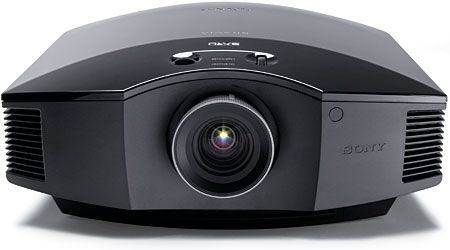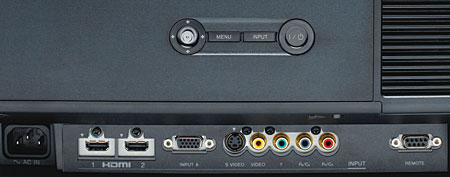Sony BRAVIA VPL-HW15 SXRD Projector
 Price: $3,000 At A Glance: Deep blacks • Accurate color • Superb image depth
Price: $3,000 At A Glance: Deep blacks • Accurate color • Superb image depth
Sony’s new BRAVIA VPL-HW15 is a reworking of last year’s VPL-HW10. At a modest $3,000 (modest as projectors go, that is), the VPL-HW15 offers a useful lineup of features and a picture that I didn’t expect at this price. With exceptional color, barely short of state-of-the-art blacks, and vivid, almost 3-D images on the best program material, it…. OK, I’m in danger of giving away the store up front. Read more to get the details.

Description
The VPL-HW15’s gently curved top echoes the look of Sony’s higher-end VPL-VW85, while the lens that recesses into a sculpted front panel does not. The controls and inputs are located on the side.
Sony’s SXRD technology is at the heart of all of Sony’s premier home theater projectors. Silicon X-tal Reflective Display (SXRD) is Sony’s proprietary version of Linear Crystal on Silicon (LCOS), a reflective version of LCD different enough to earn it a unique name. In a conventional LCD, the light passes through the liquid crystal imaging elements once on its way to the lens. But that means the control circuits that drive each pixel must pass through the gaps between the pixels. In an SXRD or LCOS, the light passes through a thinner liquid crystal imaging panel, is reflected back through it a second time, and then proceeds down the optical path to the lens. Therefore, the circuits that control each pixel can be located behind the liquid crystal panel and the reflective surface. This allows the SXRD pixels to be positioned closer together than in a transmissive LCD, which maximizes the amount of chip area that’s devoted to the picture rather than to the spaces between the pixels.
To ensure that the three chips that produce the red, green, and blue elements of the picture are in precise alignment, the Sony provides controls that let you electronically tweak the position of the three separate images within a small fraction of a pixel (small convergence errors aren’t uncommon in multi-imaging-chip projectors). To my knowledge, this is a unique feature for a projector in this price class. You can only use this feature with an internal crosshatch test pattern, which doesn’t always match the alignment visible from external sources. This required some trial and error to get things right, but in a few minutes, I converged the center of the screen almost perfectly, with insignificant deviations elsewhere. (The more expensive VPL-VW85 offers full screen and zone alignment.)
The projector’s zoom lens will fill a 100-inch-diagonal (87-inch-wide) 16:9 screen at distances that range from 10.7 to 15.9 feet. All of the lens functions (zoom, focus, and horizontal and vertical shift) are manual.
There are six different picture modes. You can adjust all of them manually, but some of the controls are locked out for certain types of inputs. You can select a different picture mode for each input (including three user modes), but you cannot set up each mode separately for each input.

Sony’s Cinema Black Pro menu includes the Advanced (auto) Iris feature. It offers two active settings plus the option of Fast, Slow, or Recommended sensitivity. I used the Advanced Iris in the Recommended setting, Auto 1, for all of my testing and viewing, unless otherwise noted.
The projector offers six gamma correction settings, including off (Gamma 2). Gamma determines how the light output varies in the mid-brightness region in response to the source input. Gamma 4, at approximately 2.0 (but dropping to about 1.8 at 80 IRE), produced a lower gamma number than the 2.2 to 2.4 usually recommended, but it worked well for me in all types of scenes, including very dark ones. (The lower the gamma number, the higher the mid-tone brightness.)
There are seven color-temperature selections, four of them Custom. The High, Middle, and Low settings cannot be changed by the user, but each of the Custom settings offers both high (Gain) and low (Bias) settings for red, green, and blue.
Sony’s Real Color Processing (RCP) feature provides Color and Hue adjustments for each of the primary and secondary colors. I have always found RCP to be ergonomically confusing, but this time around, I used it to make the color points slightly more accurate. However, that resulted in another problem that couldn’t be satisfactorily corrected—slightly excessive brightness for each color, in different degrees, for which there were no corrective controls. Ultimately, I accepted the small color gamut errors in the Normal Color Space setting and left RCP off.
There are no individual color isolation controls (red, green, or blue, or just blue only) to assist in setting the Color and Tint controls without having to use color filters, which are often imprecise.
While the Sony has the usual aspect ratio selections, it doesn’t have an anamorphic stretch mode for using an optional anamorphic lens with a 2.35:1 screen.
The Sony also offers a Black Level Adjust control (I left this off), Noise Reduction (didn’t need it), Film mode (left it in Auto), x.v.Color (suitable sources are rare), and Color Space (Normal is very close to accurate; Wide is not).
The remote control is good, with direct selection of many video adjustments—but not of inputs—and full backlighting. A lens control calls up a geometric pattern that’s helpful for adjusting the zoom and lens shift controls.
Performance
As shown in the Video Test Bench chart, the Sony’s video processing was good, apart from a not uncommon failing score on the SD 2:2 test. Like other SXRD (and LCOS) displays we’ve tested, the Sony produced a pink discoloration on all single-pixel (maximum resolution) HD luma test patterns, as well as a 1:1 pixel-to-pixel test pattern (which was otherwise perfect, provided the overscan and/or keystone controls are turned off). However, the discoloration was only visible on test patterns. As was our past experience, this pink shift didn’t affect normal program material in any visible way.
By a small margin over the Epson, the Sony was the quietest of these three quiet projectors, in both of its lamp settings. The Low setting provided more than sufficient brightness on my screen. As with all of these projectors, the Sony has enough light output in reserve for a comfortably large screen—or enough spare output to help compensate for reasonable lamp aging.
Sony has been refining the auto irises in its projectors for many years now—longer than anyone, to my knowledge. I never saw it operating (pumping) on program material, heard any sign of it operating, or noticed anything unnatural in its performance.




























































